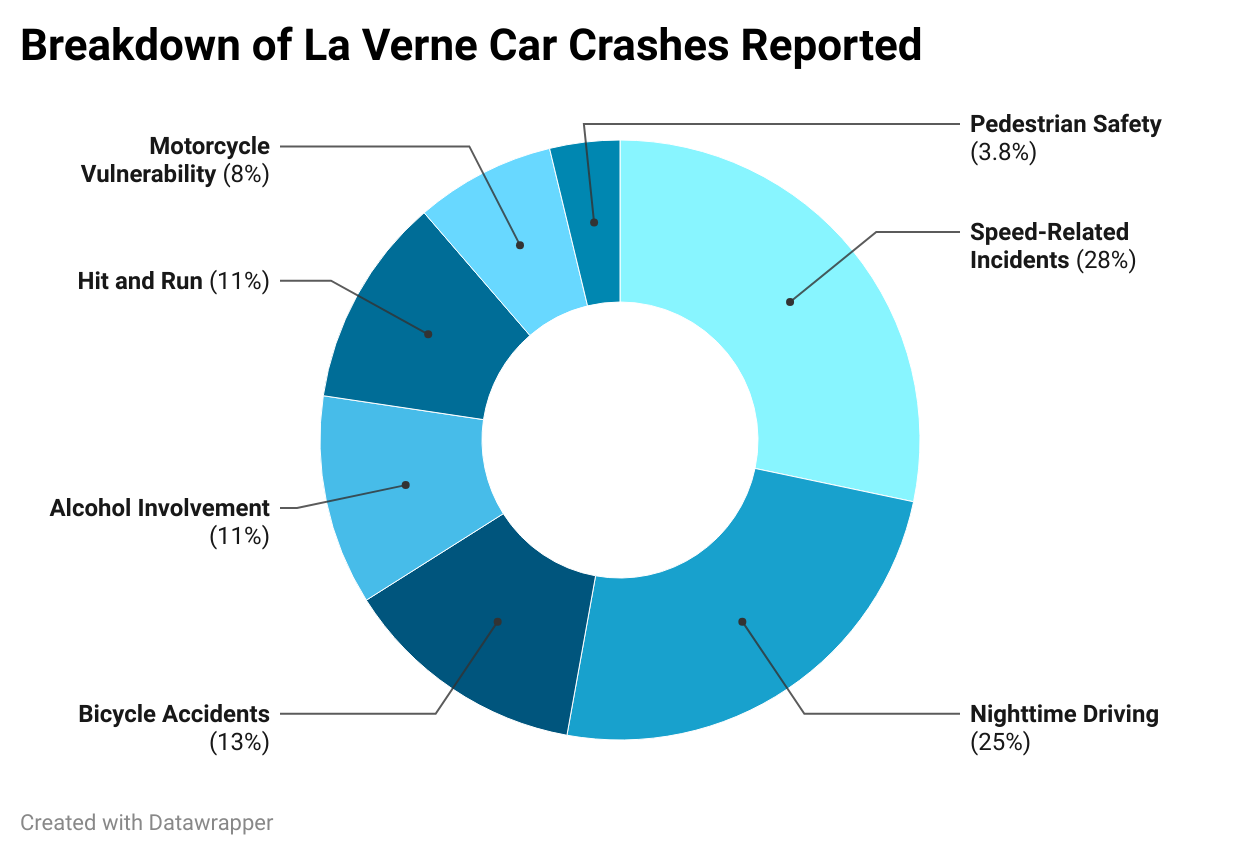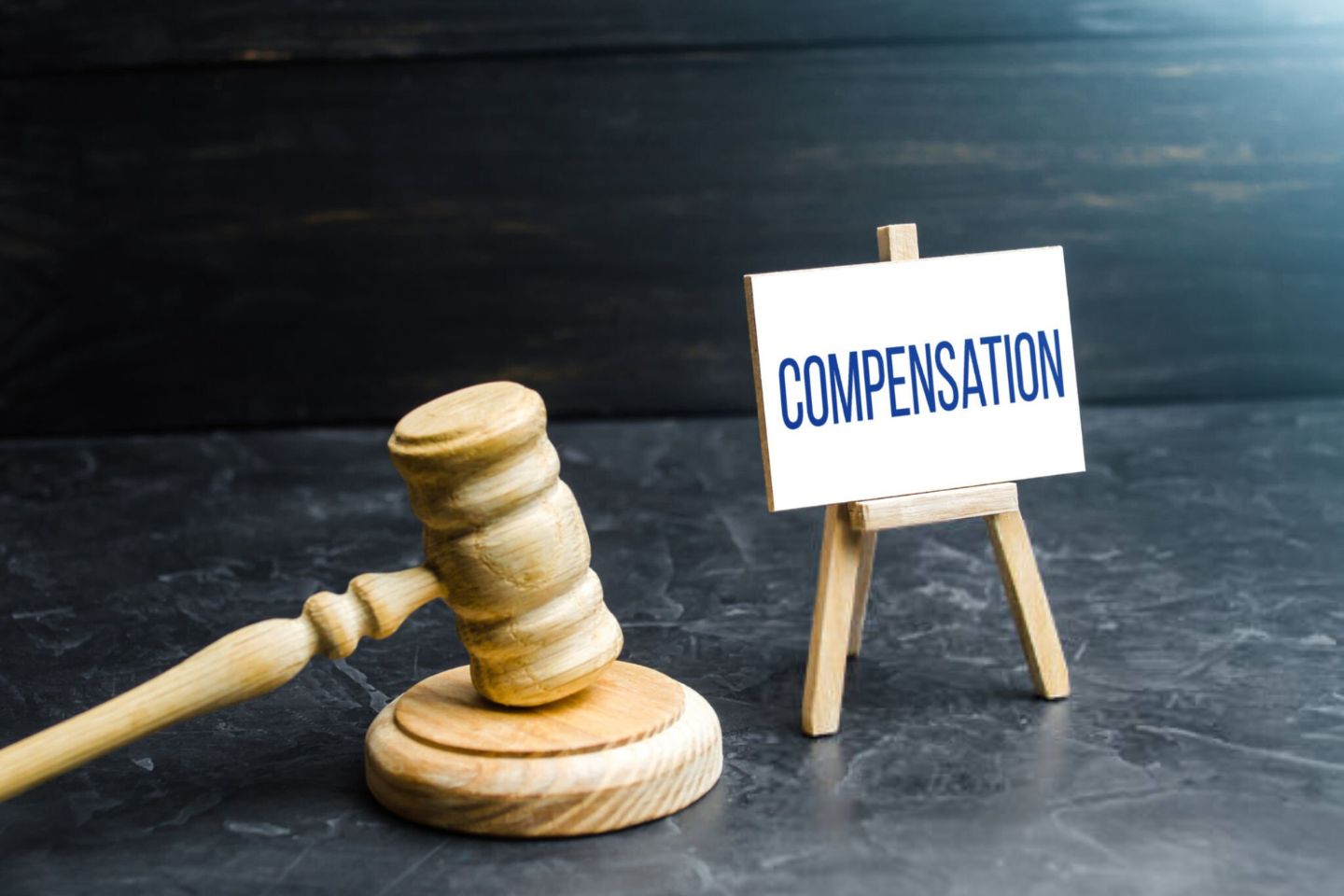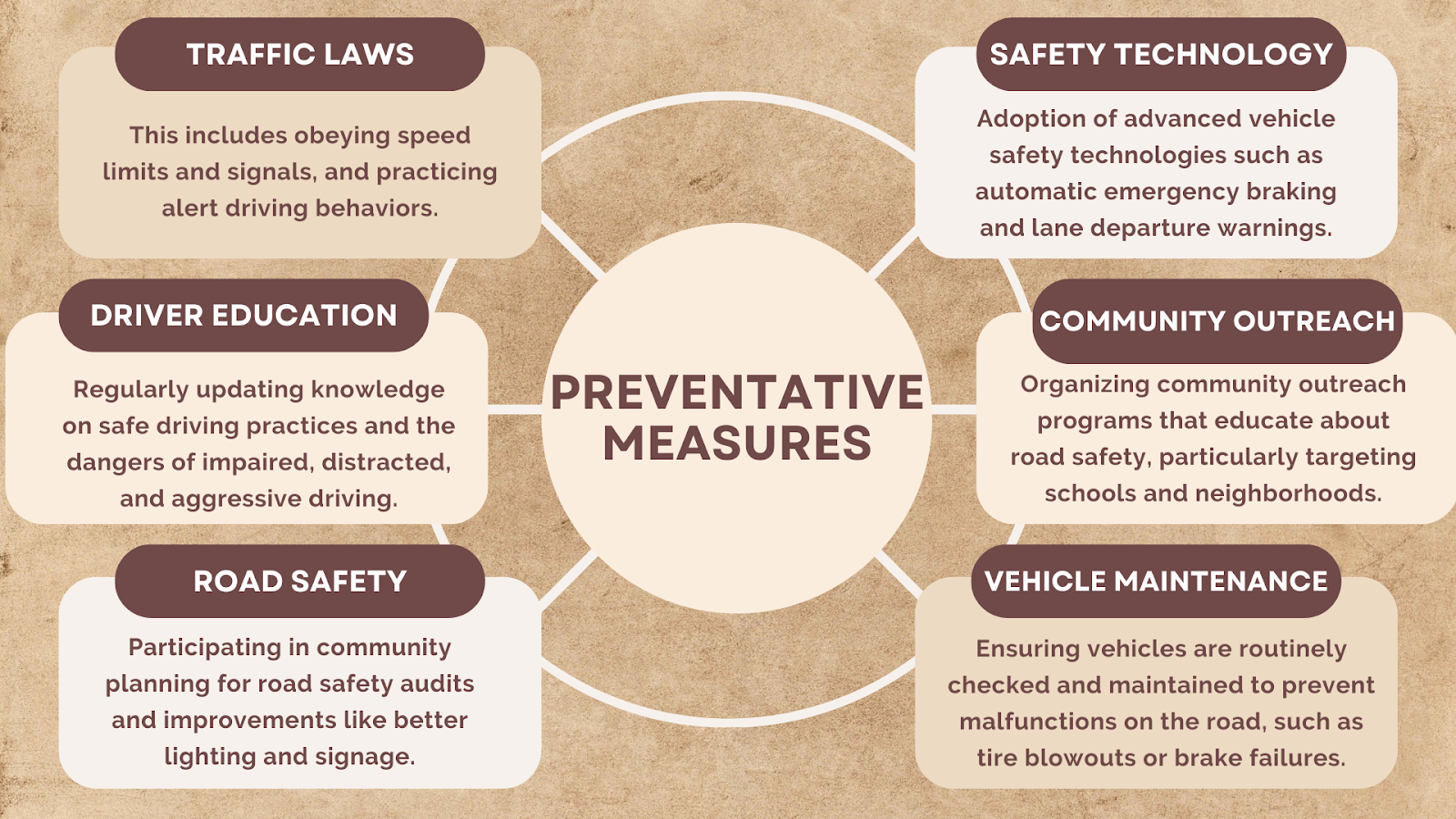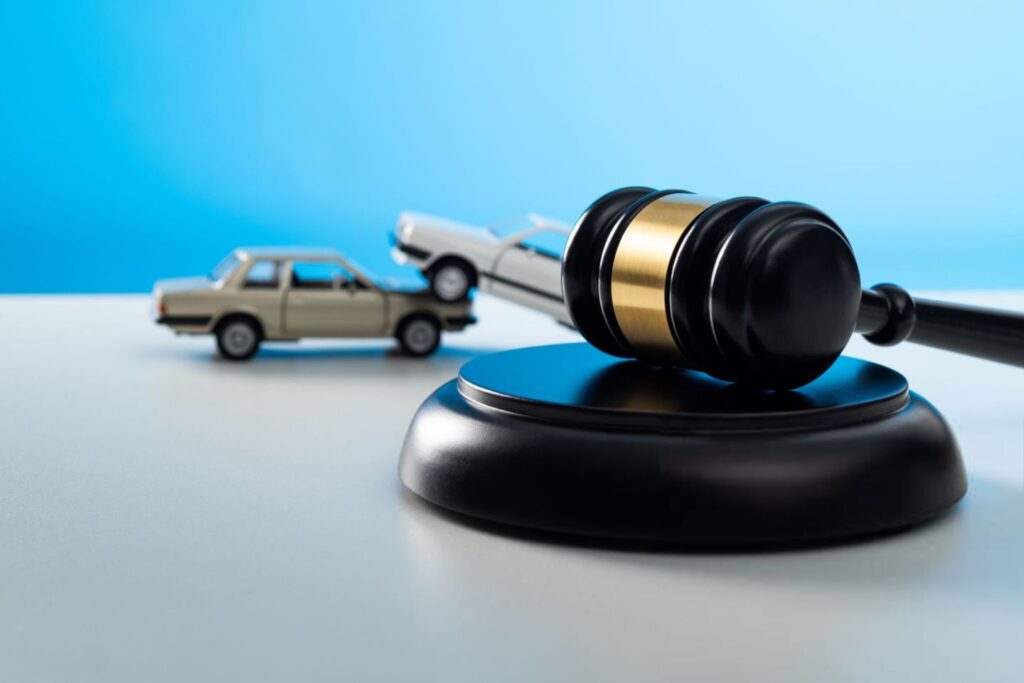Navigating the aftermath of a car accident in California can be complex, given the state’s significant share of the nation’s traffic fatalities. In 2021, California accounted for approximately 10% of all traffic fatalities in the U.S., with 4,285 fatalities out of 42,939. This statistic highlights the importance of understanding the legal landscape for anyone involved in a car crash.
In this article, we will explore the causes of car accidents in California, focusing on the specific legalities surrounding crashes in La Verne. By providing a clear overview of La Verne crash laws, our goal is to offer valuable insights for those seeking guidance in the wake of an accident.
Causes of Traffic Accidents in La Verne
According to the OTS (Office of Traffic Safety) rankings report for 2021, traffic accidents in La Verne are affected by various elements, which when combined, create perilous conditions for drivers, riders, and pedestrians alike.
Below are the key factors that have contributed to accidents in the area:


- Speed-Related Incidents: Excessive speed plays a significant role in traffic incidents, with 15 speed-related crashes recorded in 2021, underscoring the need for speed regulation enforcement.
- Nighttime Driving: The risks of driving after dark are pronounced, with 13 nighttime crashes reported, highlighting the dangers associated with lower visibility and driver fatigue.
- Alcohol Involvement: Driving under the influence remains a serious issue, with six alcohol-involved incidents, demonstrating the lethal consequences of impaired driving.
- Motorcycle Vulnerability: Motorcyclists are particularly exposed to the dangers of the road. La Verne saw four motorcycle-related accidents, calling for increased awareness and protective measures for motorcyclists.
- Pedestrian Safety: The vulnerability of pedestrians, especially the elderly, is clear, with two accidents involving pedestrians over 65 years of age reported.
- Bicycle Accidents: Cyclists also face significant risks, as evidenced by seven bicycle-related accidents, indicating potential issues with road sharing and visibility.
- Hit and Run: The report also indicates a worrying pattern of hit-and-run incidents, with six such occurrences, pointing to a need for better accountability and legal compliance from drivers.
If you’ve been affected by a La Verne crash and believe negligence played a role, it’s crucial to understand your legal rights. Contact the Personal Injury Center to get connected with experienced personal injury lawyers in your region.
Steps to Take Immediately After a La Verne Crash
In the disorienting moments following a car accident in La Verne, it’s crucial to have a clear plan of action. The actions you take can have lasting implications for your health, safety, and legal rights.
Here are the vital steps to take right after a collision, aligned with La Verne’s legal requirements.
Ensure Safety and Call for Help
In the immediate aftermath of a crash, your first priority should be safety. Find a safe location away from the flow of traffic to minimize any further risks to yourself and others. California Vehicle Code Section 20002(a) mandates that you must stop your vehicle without obstructing traffic or placing anyone in danger.
Once in a secure location, call 911. This call is essential for two key reasons: it ensures that anyone injured receives medical attention promptly and it alerts emergency services to the situation, ensuring the scene is managed safely and effectively.
Exchange Information
California Vehicle Code Section 16025 directs the exchange of specific information between parties involved in an accident. This includes names, addresses, driver’s license numbers, vehicle identification numbers, and insurance details. Collecting contact information from witnesses is also invaluable. This step ensures everyone involved has the necessary details for insurance claims and potential legal processes.
Document the Scene
Capturing photos and videos of the La Verne crash site, vehicle damages, and any road conditions can significantly support your case. This visual documentation serves as objective evidence of the accident’s context and impact, helping to clarify what happened.
Report the Accident
You must report the accident to the California Highway Patrol or local police within 24 hours if it results in injury or death, as stated in California Vehicle Code Section 20008. Not reporting can lead to legal penalties. This formal report can be a critical piece of documentation for insurance or legal actions.
Seek Medical Attention
Even if you feel fine, some injuries may not be immediately noticeable. Getting a medical evaluation right away is important, as it creates a record of any injuries related to the crash. You have two years to file a personal injury claim, as stated in California Civil Procedure Section 335.1, but early documentation is key to linking your injuries directly to the accident.
Notify Your Insurance
California law outlined in California Insurance Code §11580.1b requires all drivers to carry minimum liability insurance coverage which covers damages to others if you’re at fault in an accident. You should contact your insurance company and inform them about the accident as soon as possible. When you call, be mindful of the information you share. Avoid admitting fault or making statements that might be used against you, as these can affect your claim.
Consult With a Legal Professional
Lastly, it is advisable to consult with an attorney who specializes in personal injury law, especially if there are significant damages or injuries. A legal professional can provide advice on how to proceed and can help protect your rights throughout the process.
After ensuring your immediate safety and fulfilling the necessary legal obligations following an accident, it’s crucial to consider your legal rights. Visit the Personal Injury Center for professional guidance. Our connections with experts in the personal injury field can help you navigate the complexities of your situation and support you in seeking fair compensation.
How La Verne’s Crash Laws Affect Compensation


In La Verne, as in the rest of California, the compensation you may receive after a car accident is influenced by several laws designed to determine liability and the extent of damages that can be recovered.
Comparative Fault
In California, the concept of “pure comparative negligence” plays a crucial role in determining how compensation is awarded after a traffic accident. Essentially, this principle, outlined in California Civil Code 1714, allows for damages to be allocated based on each party’s degree of fault in the accident.
This means that even if you’re found to be partially at fault—for instance, 30% responsible—you can still recover 70% of the total damages awarded. This system ensures that compensation is fair and proportionate to the involvement in the accident.
To learn more about how comparative negligence works through an example, you can watch this video.
Type of Damages Incurred
After an accident in La Verne, victims might wonder what compensation they’re entitled to.
Damages fall into two main categories:
- Economic Damages: These are the tangible costs you’ve incurred, such as medical expenses, lost earnings due to time off work, and any property damage like car repairs.
- Non-Economic Damages: These cover the intangible impacts of an accident on your life, including pain and suffering, emotional distress, and a decrease in life enjoyment. Calculating these amounts involves assessing how the accident has affected your overall quality of life.
- Punitive Damages: In cases where the defendant’s actions were especially harmful or reckless, the court might award punitive damages. These are not tied to the victim’s losses but are intended to punish the wrongdoer and deter similar future behavior. Though less common, they can significantly increase the total compensation in egregious cases.
Statute of Limitations
In California, the law sets strict deadlines for when you can legally file a lawsuit after a car accident. This deadline is known as the statute of limitations. Specifically, for personal injury claims—like if you were hurt in the accident—you have two years from the accident date to file your lawsuit. If your claim is for property damage, such as damage to your car, you have three years from the accident date to file.
- Example: Here’s an example to clarify: If you’re involved in a car accident on January 1, 2023, you would have until January 1, 2025, to file a lawsuit seeking compensation for any injuries you suffered. For any car repairs or other property damages, you have until January 1, 2026, to file.
Missing these deadlines can result in losing your right to claim compensation altogether. It’s a crucial aspect of the legal process, emphasizing the need to act quickly and consult with a legal professional if you’re considering pursuing a lawsuit for damages from a car accident.
Breach of Duty of Care
In California’s traffic laws, a “breach of duty of care” means a driver didn’t act as safely as a reasonable person would have in the same situation. This idea is key for cases where someone is blamed for causing harm (negligence) and is based on California Civil Code Section 1714(a). This law explains that everyone must act with reasonable care to avoid causing harm to others, whether through their actions or by failing to act.
A simple way to think about a breach of duty could be a driver who is texting, speeding, or driving after drinking. These actions go against the basic responsibility every driver has to keep the roads safe for everyone. To win a case for personal injury, showing that someone didn’t meet this responsibility is a critical step.
Preventative Measures to Avoid Future Accidents in Le Verne
While understanding the legalities of car accidents is important, preventing such incidents should be a primary concern for all drivers in La Verne. By taking proactive steps, individuals and communities can work together to reduce the likelihood of accidents and improve overall road safety.


- Strict Adherence to Traffic Laws: Obeying speed limits and signals, and practicing alert driving behaviors are fundamental for preventing accidents.
- Continual Driver Education: Regularly updating knowledge on safe driving practices and the dangers of impaired, distracted, and aggressive driving can mitigate risks.
- Road Safety Improvements: Advocating for and participating in community planning for road safety audits and improvements like better lighting and signage.
- Safety Technology in Vehicles: Encouraging the adoption of advanced vehicle safety technologies such as automatic emergency braking and lane departure warnings.
- Community Outreach: Engaging in or organizing community outreach programs that educate about road safety, particularly targeting schools and neighborhoods.
- Regular Vehicle Maintenance: Ensuring vehicles are routinely checked and maintained to prevent malfunctions on the road, such as tire blowouts or brake failures, which can lead to serious accidents.
Connect With Expert Lawyers Through the Personal Injury Center
Facing the aftermath of a traffic accident requires reliable information and access to expert legal counsel. At the Personal Injury Center, our team of experts specializes in linking victims to seasoned personal injury attorneys, tailored to meet the specific needs of their cases.
If you need legal advice or assistance, contact us for a free evaluation of your case. We specialize in understanding your needs and ensuring you’re matched with a lawyer who can provide the best support and representation for your situation. Let us help you navigate the path to justice and compensation.
Key Takeaways
|



